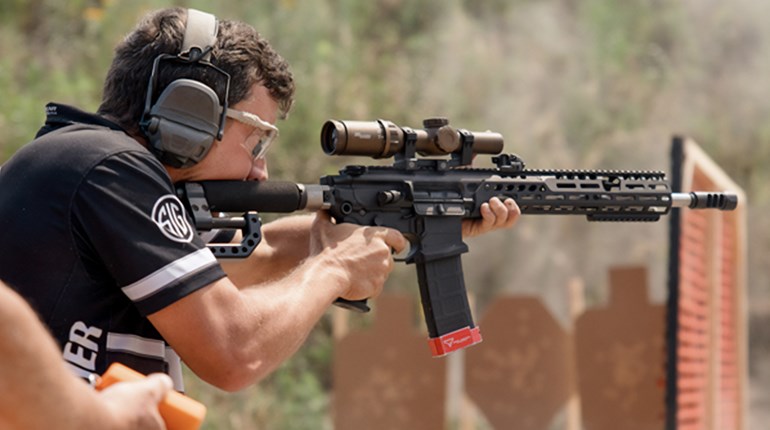
In 2010, the National Firearms Museum opened its newest gallery: The Robert E. Petersen Gallery, an exceedingly generous gift from Marjorie Petersen and the R. E. Petersen Foundation. To date, it remains the largest gift ever made to the NRA Foundation, conservatively estimated to be valued at around $32 million in exquisite firearms and financial donations.
Of the 425 firearms donated, there is one pistol that stands out for its beauty and simple form, a SIG Sauer P210. Encased in a fine walnut box, plush lined and French fitted with the SIG logo embossed on the inside of the lid, it is one of only 2,000 SIG P210s manufactured for the 700th Anniversary Jubilee of the Swiss Confederation. It has a beautiful nitre-blue finish with gold accents. It is marked in gold with the serial number on the slide and frame. “Confoederatio Helvetica” on the right of the frame and “1291” and “1991” on the left are also inscribed in gold. It is stocked in ivory with a simple Swiss cross scrimshawed at the base of the grips.
Robert E. Petersen was the founder/owner of Petersen Publishing, a publisher of 39 monthly magazines. At the time of his death, he had collected in excess of 2,000 firearms, most of them high-grade sporting arms. Among his handguns were numerous examples of the finest guns produced by most of the world’s major manufacturers. Exquisite Colts and Smith & Wessons as well as the finest Howda pistol by Alex Henry and others surround the fire-blue SIG, a standout in the display case.
My personal collecting interest had mostly, up until that time, confined itself to Civil War through World War II firearms. Yet, there was something about this stunning SIG that captured my eye and led me to look into something I had previously known little-to-nothing about. My journey of discovery led me down a rabbit hole that has resulted in SIG’s now almost equaling the number of Webley’s and Colts in my safe. Sadly, one of these 2,000 SIG Swiss anniversary P210’s hasn’t made it into the collection, as they are rarely seen on the market in the U.S. and command prices in excess of $5,000 when they do.
One of the compelling aspects of the SIG was its rich history. Founded in 1853 as Schweizerische Waggon Fabrik (Swiss Wagon Factory), the founders designed and developed a single-shot, muzzleloading rifle for the Swiss Army. Its design was adopted in 1863 and, with a contract to build 30,000 of them, they changed their name to Schweizerische Industrie Gesellschaft (SIG, Swiss Industrial Company) to better reflect its new business.

As the dark clouds of war settled over Europe in the 1930s, many nations found themselves woefully unprepared in terms of armaments, both in quality and quantity. The French and the Swiss both established commissions to select and field-trial new semi-automatic pistols for possible adoption, with the French gaining a head start on the Swiss by a few years. In 1935, the French had settled on a pistol termed the Model 1935A.
The 1935A had in its family tree a number of design ideas and patents that had been originally conceived by—I’m sure you’ve guessed it—John M. Browning, the world’s most prolific firearms designer. Browning had been in the Herstal, Belgium, office of his son, Val Browning, working on a new pistol design (which would eventually become the famous Hi Power) when he died in 1926. The new prototype was to be a contender for the French Pistol Commission’s search for a new semi-automatic. Dieudonné Joseph Saive of FN finished the design, incorporating more of Browning’s patents from the Colt 1911 that had expired in 1931. The resulting pistol was the Hi Power, of which nearly 2 million have been produced and are still in use by police and military forces worldwide.
However, the French went with the Model 1935A designed by Swiss Army officer Charles Gabriel Petter, who combined the best aspects of the 1911 patents and modified them to create the M1935A. Sadly for the French, the adoption and manufacture of the M1935A never got to full steam before World War II erupted. Only 85,000 were made.
In 1937, SIG acquired a license to use the patents from the Browning-Petter M1935A pistol and started to test and evaluate it for adoption by the Swiss Army. After a decade and nearly 14 other competing designs, the SIG M47/8 was adopted and began production in 1949. Adopted by the Danish Military as well, the pistol was eventually marketed and cataloged under the name SIG P210 in 1957. In 1975 SIG acquired the firearm firm of J. P. Sauer & Sohn (established in 1751) of Germany, so they could comply with Swiss export laws and therefore market the P210 around the world.
The newly renamed company, SIG Sauer, then established a base in Virginia in 1985 and moved to a manufacturing facility in Exeter, NH, in 1990. The SIG Sauer P210 has been made in the U.S. since 2010, and more than 400,000 have been manufactured in Europe and the U.S. to date.




































